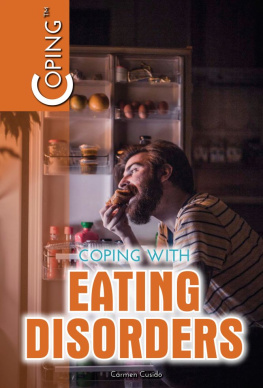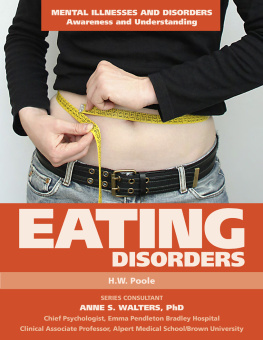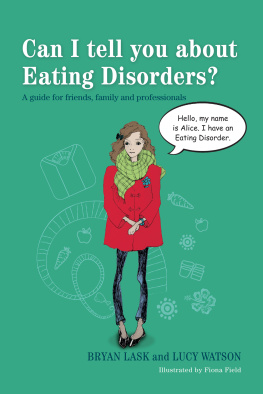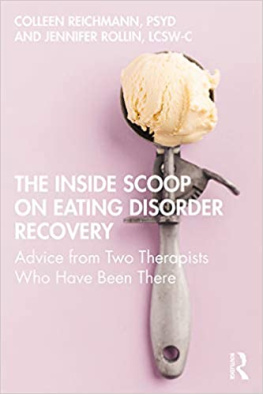Published in 2019 by The Rosen Publishing Group, Inc.
29 East 21st Street, New York, NY 10010
Copyright 2019 by The Rosen Publishing Group, Inc.
First Edition
All rights reserved. No part of this book may be reproduced in any form without permission in writing from the publisher, except by a reviewer.
Library of Congress Cataloging-in-Publication Data
Names: Cusido, Carmen, author.
Title: Coping with eating disorders / Carmen Cusido.
Description: First edition. | New York : Rosen YA, 2019. | Series: Coping | Audience: Grades 7-12. | Includes bibliographical references and index. Identifiers: LCCN 2018016579| ISBN 9781499467154 (library bound) | ISBN 9781508183174 (pbk.)
Subjects: LCSH: Eating disordersTreatmentJuvenile literature. Classification: LCC RC552.E18 C875 2019 | DDC 616.85/2600835dc23 LC record available at https://lccn.loc.gov/2018016579
Manufactured in the United States of America
CONTENTS
CHAPTER ONE
Understanding Eating Disorders
CHAPTER TWO
What Triggers Eating Disorders?
CHAPTER
THREE Medical Care and Other Treatment
CHAPTER FOUR
Recovery and Relapse
G rowing up, Full House star Candace Cameron Bure had a healthy body image, but that changed when the then twenty-year-old actress moved from California to a Canadian city where she didnt know many people. The problems arose for Bure soon after she stepped away from the Hollywood spotlight after marrying her ice hockey-player husband, Valeri Bure, in 1996. The actress said she turned to food for comfort, and that unhealthy relationship turned into a bout with bulimia.
I dealt with [bulimia] for several years but it wasnt about body image and trying to feel goodit was about trying to find comfort or fill voids within myself, the actress told ET in a 2016 interview. I was sitting in church and I was by myself, my husband was on the road. The sermon somehow just spoke to my heart and thats when I went directly to my pastor and said, I need help ... That was the moment that I went, I dont want to do this anymore.
Bure, who now stars in Fuller House on Netflix, is a spokesperson for the Eating Recovery Center and was an ambassador for the centers first Eating Recovery Day when it launched in 2016. By speaking out about her experience with bulimia, Bure hopes to illustrate that it is possible to recover from an eating disorder. It may take time and treatment though.
.jpg)
Eating disorders include well-known illnesses such as anorexia nervosa, bulimia nervosa, and binge eating disorder, as well as some much rarer conditions. About thirty million people in the United States will experience eating disorders in their lifetimes, and these disorders are the third-most common chronic illnesses in adolescents, according to the American Academy of Pediatrics. In Canada, nearly one million people meet the diagnostic criteria for an eating disorder, according to the National Eating Disorder Information Centre. Eating disorders are the most common chronic illnesses among female adolescents, with up to 5 percent of that population affected, according to Hopewell, a nonprofit eating disorder support center based in eastern Ontario.
Eating disorders can be triggered by a number of factors. Some people are genetically predisposed to starve themselves or binge and purge or become susceptible to other disordered eating behaviors. Some people suffer from eating disorders because they have low self-esteem and body-image issues for example, a person might see herself as fat when she is actually a normal weight or underweight. Other times, eating disorders are triggered by traumatic events such as physical or sexual abuse or the loss of a loved one.
Although eating disorders are a huge problem for many people, it is possible to overcome these illnesses. There are various effective treatments that can pave the way for recovery. Whether you think you may have an eating disorder yourself or are concerned about a loved one with disordered eating habits, it is important to learn the facts about eating disorders in order to understand how to cope with them.
T he most common eating disorders diagnosed in the United States are anorexia nervosa, bulimia nervosa, and binge eating disorder (BED), though there are a number of other conditions that are recognized by the Diagnostic and Statistical Manual of Mental Disorders, 5th edition (DSM-5). Published by the American Psychiatric Association since the 1950s, this manual defines mental illnesses in order to improve their diagnoses, treatment, and research.
Eating disorders are serious mental illnesses that can severely impact a persons physical and emotional health and can impair the persons ability to function in everyday life. The conditions often develop in adolescence and young adulthood, though people of all ages have been diagnosed with eating disorders.
Symptoms vary based on the type of eating disorder, but generally these illnesses can cause serious damage to the heart, bones, digestive system, teeth, and mouth and can lead to other complications, diseases, and even death.
What Is Anorexia Nervosa?
One ofthe three main types ofeating disorders, anorexia nervosa is manifested when individuals refuse to maintain the minimal weight for their body mass index, restrict their food intake, have a distorted body image and an intense fear of becoming fat (typically weighing themselves repeatedly), and have an abnormal fear of food.
A person with anorexia may not exhibit all the signs and symptoms of the disease right away. Some of the emotional and behavioral signs of the illness include drastic weight loss; dressing in layers to hide the weight loss or to stay warm; a preoccupation with dieting, fat grams, weight, and calories; refusing to eat certain foods; denying feeling hungry; developing food rituals, such as eating foods in certain orders or rearranging food on a plate; cooking meals for others but not eating; frequently making excuses to avoid situations involving food; social withdrawal; and loss of menstrual periods in adolescents and adults.
Physical symptoms that develop over time include stomach cramps, difficulty concentrating, muscle atrophy (when muscles waste away), dizziness and fainting, sleep problems, feeling cold often, anemia, brittle hair and nails, dry and yellowish skin, low blood pressure, and brain and heart damage.
Though anorexia typically begins in adolescence, the disorder can affect people of any age, gender, sexual orientation, economic background, and ethnicity.
Good Morning America meteorologist Ginger Zee began a four-year battle with anorexia after her parents divorced when she was ten years old. In her book, Natural Disaster: I Cover Them. I Am One,










.jpg)
.jpg)
.jpg)
.jpg)
.jpg)